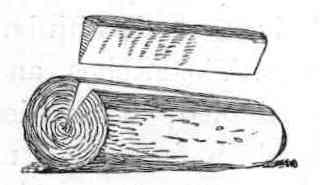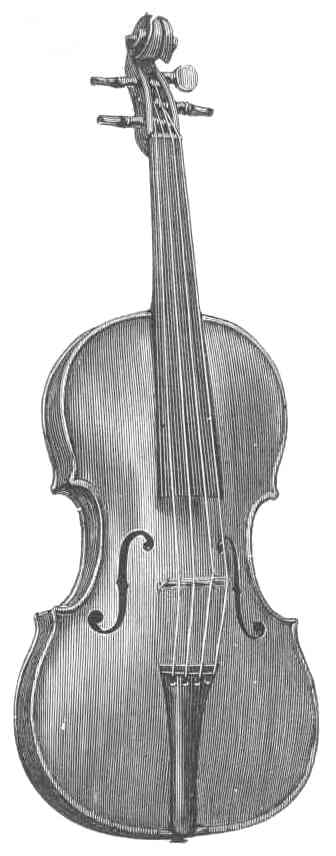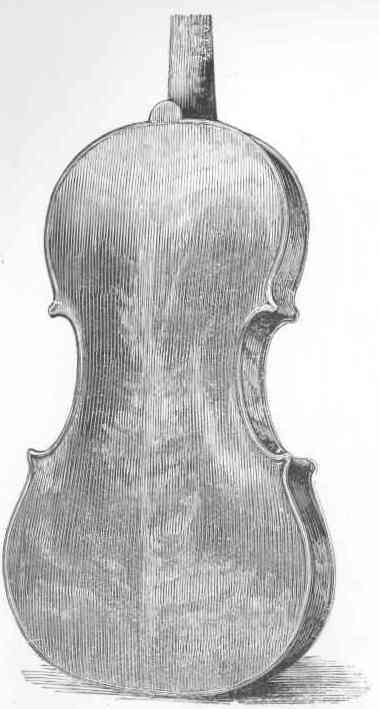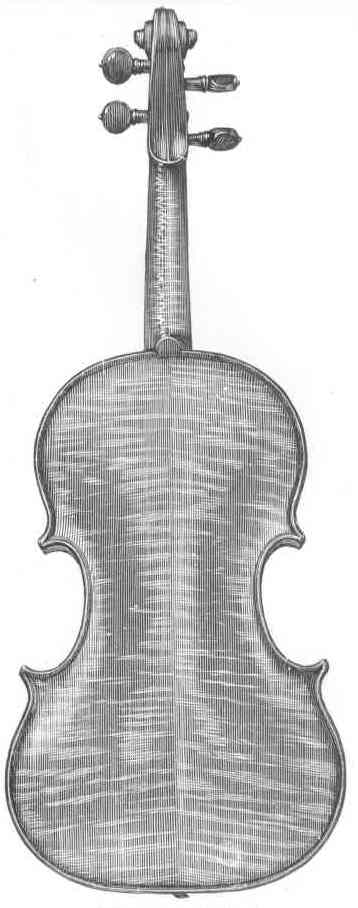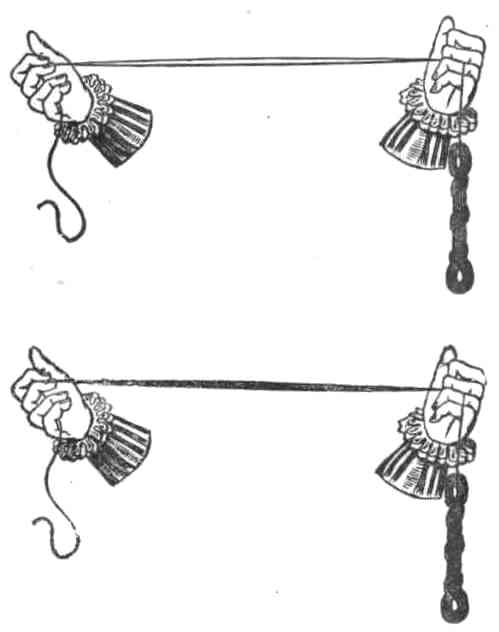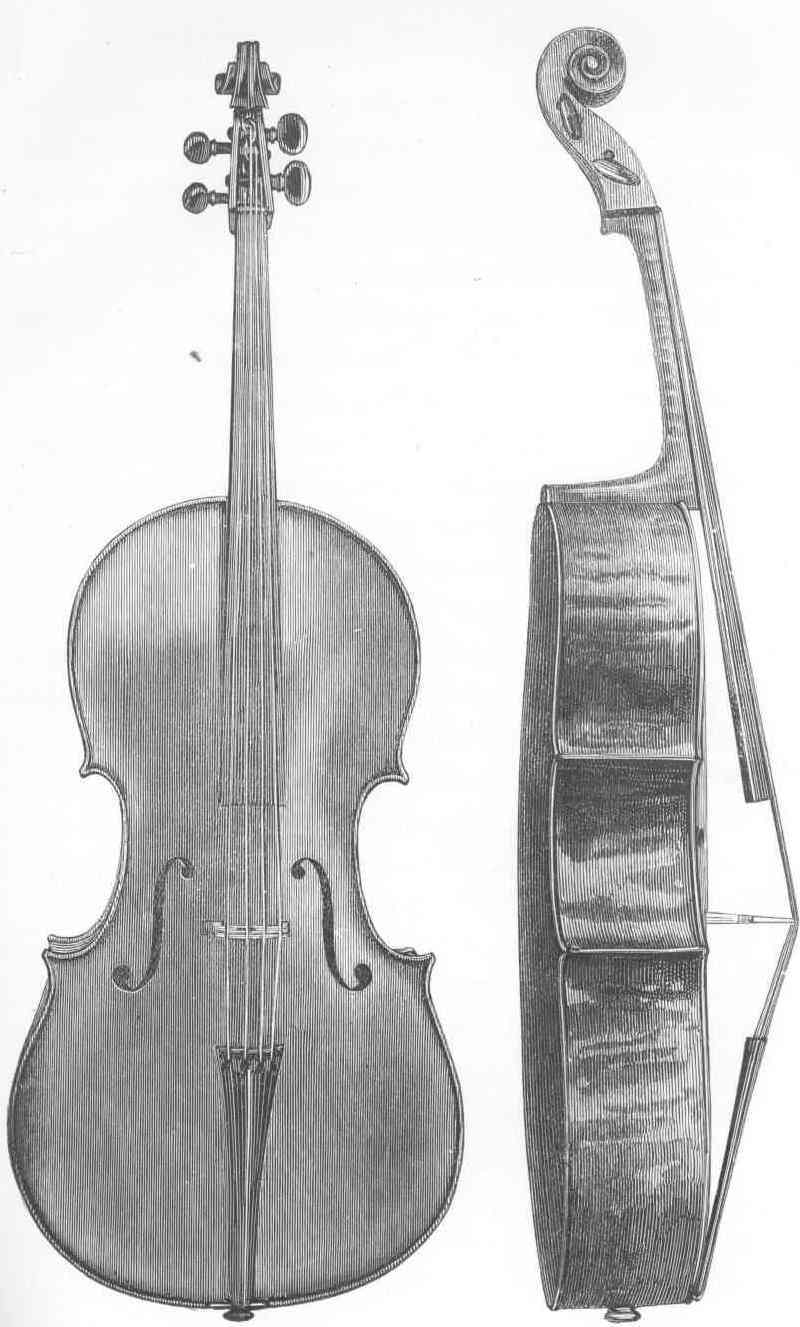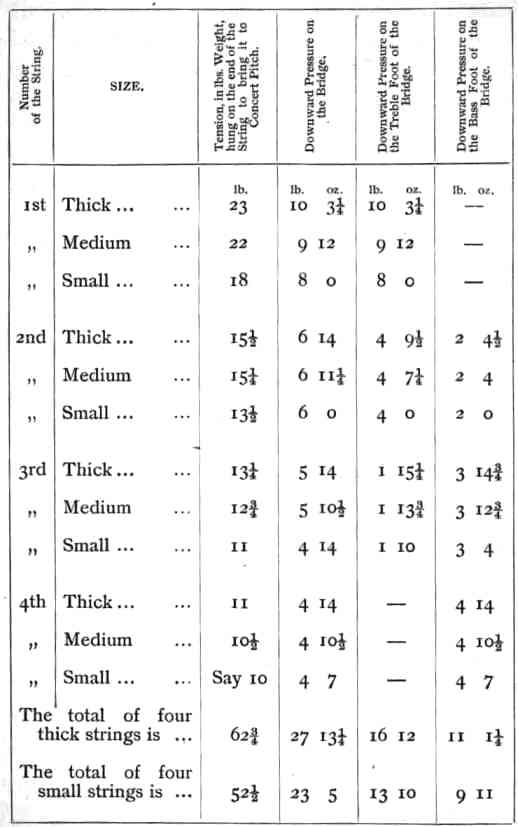 |
THEHISTORY OF MUSIC LIBRARY |
 |
SECTION II The Construction of the Violin The construction
of the present form of the Violin
has occupied the attention of many scientific men. It cannot be
denied that the subject possesses a charm sufficiently powerful
to induce research, as endeavour is made to discover the causes
for the vast superiority of the Violin of the seventeenth century
over the many other forms of bow instruments which it has survived.
The characteristic differences of the Violin have been obtained
at the cost of many experiments in changing the outline and placing
the sound-holes in various incongruous positions. These, and the
many similar freaks of inventors in their search after perfection,
have signally failed, a result to be expected when it is considered
that the changes mentioned were unmeaning, and had nothing but novelty
to recommend them. But what is far more extraordinary is the failure
of the copyist, who, vainly supposing that he has truthfully followed
the dimensions and general features of the Old Masters, at last
discovers that he is quite unable to construct an instrument in
any way deserving of comparison with the works of the period referred
to. The Violin has thus hitherto baffled all attempts to force it
into the "march of progress" which most things are destined
to follow. It seems to scorn complication in its structure, and
successfully holds its own in its simplicity. There is in the Violin,
as perfected by the great Cremonese masters, a simplicity combined
with elegance of design, which readily courts the attention of thoughtful
minds, and gives to it an air of mystery that cannot be explained
to those outside the Fiddle world. Few objects possess so charming
a display of curved lines as the members of the Violin family. Here
we have Hogarth's famous line of beauty worked to perfection in
the upper bouts, in the lower bouts, in the outer line of the scroll,
in the sound-hole. Everywhere the perfection of the graceful curve
is to be seen. It has been asserted by Hogarth's enemies that he
borrowed the famous line from an Italian writer named Lomazzo, who
introduced it in a treatise on the Fine Arts. We will be more charitable,
and say that he obtained it from the contemplation of the beauties
of a Cremonese Violin. In looking at a Violin
we are struck with admiration at a sight of consummate order and
grace; but it is the grace of nature rather than of mechanical art.
The flow of curved lines which the eye detects upon its varied surface,
one leading to another, and all duly proportioned to the whole figure,
may remind us of the winding of a gentle stream, or the twine of
tendrils in the trellised vine. Often is the question
asked, What can there be in a simple Violin to attract so much notice?
What is it that causes men to treat this instrument as no other,
to view it as an art picture, to dilate upon its form, colour, and
date? To the uninitiated such devotion appears to be a species of
monomania, and attributable to a desire of singularity. It needs
but little to show the inaccuracy of such hypotheses. In the first
place, the true study of the Violin is a taste which needs as much
cultivation as a taste for poetry or any other art, a due appreciation
of which is impossible without such cultivation. Secondly, it needs,
equally with these arts, in order to produce proficiency, that spark
commonly known as genius, without which, cultivation,
strictly speaking, is impossible, there being nothing to cultivate.
We find that the most ardent admiration for the Violin regarded
as a work of art, has ever been found to emanate from those who
possessed tastes for kindred arts. Painters, musicians, and men
of refined minds have generally been foremost among the admirers
of the Violin. Much interest attaches to it from the fact of its
being the sole instrument incapable of improvement, whether in form
or in any other material feature. The only difference between the
Violin of the sixteenth century and that of the nineteenth lies
in the arrangement of the sound-bar (which is now longer, in order
to bear the increased pressure caused by the diapason being higher
than in former times), and the comparatively longer neck, so ordered
to obtain increased length of string. These variations can scarcely
be regarded as inventions, but simply as arrangements. The object
of them was the need of adapting the instrument to modern requirements,
so that it might be used in concert with others that have been improved,
and allow the diapason to be raised. Lastly, it must be said that,
above all, the Violin awakens the interest of its admirers by the
tones which it can be made to utter in the hands of a skilful performer.
It is, without doubt, marvellous that such sounds should be derivable
from so small and simple-looking an instrument. Its expressiveness,
power, and the extraordinary combinations which its stringing admits
of, truly constitute it the king of musical instruments. These somewhat
desultory remarks may suffice to trace the origin of the value set
upon the Violin both as a work of art and as a musical instrument. We will now proceed
to consider the acoustical properties of the Violin. These are,
in every particular, surprisingly great, and are the results of
many tests, the chief of which has been the adoption of several
varieties of wood in its construction. In Brescia, which was in
all probability the cradle of Violin manufacture, the selection
of the material of the sides and back from the pear, lemon, and
ash trees was very general, and there is every reason to believe
that Brescia was the first place where such woods were used. It
is possible that the makers who chose them for the sides and backs
of their instruments considered it desirable to have material more
akin to that adopted for the bellies, which was the finest description
of pine, and that the result was found to be a tone of great mellowness.
If they used these woods with this intention, their calculations
were undoubtedly correct. They appear to have worked these woods
with but few exceptions for their Tenors, Violoncellos, and Double
Basses, while they adopted the harder woods for their Violins, all
which facts tend to show that these rare old makers did not consider
soft wood eligible for the back and sides of the leading instrument;
and later experiment has shown them to have arrived at a correct
conclusion on this point. The experiments necessary to obtain these
results have been effected by cutting woods of several kinds and
qualities into various sizes, so as to give the sounds of the diatonic
scale. By comparing the intensity and quality of tone produced by
each sample of wood, plane-tree and sycamore have been found to
surpass the rest. The Cremonese makers seem to have adhered chiefly
to the use of maple, varying the manner of cutting it. First, they
made the back in one piece, technically known as a "whole back";
secondly, the back in two parts; thirdly, the cutting known as the
"slab back." There being considerable doubt as to the
mode of dividing the timber, the woodcuts given will assist the
reader to understand it. Fig. 1 represents the cutting for the back
in two pieces—the piece which is separated from the log is
divided. Fig. 2 shows the method adopted to obtain the slab form.
This mode of cutting
is constantly met with in the works of the Brescian makers, and
likewise in those of the early Cremonese. Andrea Amati invariably
adopted this form. Stradivari rarely cut his wood slab-form. Joseph
Guarneri made a few Violins of his best epoch with this cutting,
the varnish on which is of an exquisite orange colour, so transparent
that the curls of the wood beneath resemble richly illuminated clouds. There can be no doubt
whatever that the Cremonese and Brescian makers were exceedingly
choice in the selection of their material, and their discrimination
in this particular does not appear to have risen so much from a
regard to the beauty as to the acoustic properties of the wood,
to which they very properly gave the first place in their consideration.
We have evidence of much weight upon this interesting question in
the frequent piecings found on the works of Cremona makers, pointing
to a seeming preference on their part to retain a piece of wood
of known acoustic properties rather than to work in a larger or
better preserved portion at the probable expense of tone. The time
and care required for such a delicate operation must have been sufficient
to have enabled the maker, had he been so minded, to have made a
complete instrument. There is also ample proof that Joseph Guarneri
possessed wood to the exceptional qualities of which he was fully
alive, and the same may be said of Stradivari, Ruggeri, and others.
It is scarcely reasonable to suppose that in the seventeenth century
there was a dearth in Italy of timber suitable for the manufacture
of Violins, and that in consequence these eminent makers were compelled
to patch and join their material to suit their purpose. They were
men who were in the enjoyment of a patronage certainly sufficient
to enable them to follow their calling without privation of any
kind. Scarcity of pine and sycamore, good or bad, could not have
been the cause, since we find Italian cabinet-work of great beauty
that was manufactured at this same period. The plane-tree and pine
used by the Amati, Stradivari, and the chief masters in Italy, was
usually of foreign growth, and was taken from the Tyrol and Istria.
Its value was, therefore, in advance of Italian wood, but hardly
so much as to place it beyond the reach of the Cremonese masters.
It is, further, improbable that these masters of the art should
have expended such marvellous care and toil over their work, pieced
as it frequently was like mosaic, when for a trifling sum they could
have avoided such a task to their ingenuity by purchasing fresh
wood. We are therefore forced to admit that there must have been
some cause of great weight which induced them to apply so much time
and labour, and that the problem can only be accounted for by the
solution before proposed, viz., that external appearance was of
less importance than the possession of acoustic properties thoroughly
adapted to the old makers' purpose, and that the scarcity of suitable
wood was such as to make them hoard and make use of every particle.
The selection of material was hence considered to be of prime importance
by these makers; and by careful study they brought it to a state
of great perfection. The knowledge they gained of this vital branch
of their art is enveloped in a similar obscurity to that which conceals
their famous varnish, and in these branches of Violin manufacture
rests the secret of the Italian success, and until it is rediscovered
the Cremonese will remain unequalled in the manufacture of Violins. We may now pass to
the consideration of the various constituent parts of a Violin.
It will be found, if a Violin be taken to pieces, that it is constructed
of no less than fifty-eight separate parts, an astonishing number
of factors for so small and simple-looking an instrument. The back
is made of maple or sycamore, in one or two parts; the belly of
the finest quality of Swiss pine, and from a piece usually divided;
the sides, like the back, of maple, in six pieces, bent to the required
form by means of a heated iron; the linings, which are used to secure
the back and belly to the sides, are twelve in number, sometimes
made of lime-tree, but also of pine. The bass or sound-bar is of
pine, placed under the left foot of the bridge in a slightly oblique
position, in order to facilitate the vibrating by giving about the
same position as the line of the strings. The divergence is usually
one-twelfth of an inch, throughout its entire length of ten inches.
It is curious to discover that this system of placing the bar was
adopted by Brensius of Bologna, a Viol-maker of the fifteenth century,
and by Gasparo da Sal�. The later Violin-makers, however, for the
most part, do not appear to have followed the example, they having
placed it in a straight line, thus leaving the system to be re-discovered.
The bar of the Violin not only serves the purpose of strengthening
the instrument in that part where the pressure of the bridge is
greatest, but forms a portion of the structure at once curious and
deeply interesting; it may indeed be called the nervous system of
the Violin, so exquisitely sensitive is it to external touch. The
slightest alteration in its position will effect such changes in
the tone as often to make a good Violin worthless. Those troublesome
notes technically known as "wolf notes" by its delicate
adjustment are sometimes removed, or passed to intervals where the
disagreeable sound is felt with less intensity. Numerous attempts
have been made to reduce these features to a philosophy, but the
realisation of the coveted discovery appears as distant as ever.
The most minute variation in the construction of the instrument
necessitates a different treatment of this active agent as regards
its conjunction with the bridge; and when it is considered that
scarcely two Violins can be found of exactly identical structure,
it must be admitted that the difficulties in the way of laying down
any set of hard and fast rules for their regulation seem to be insuperable. The next important
feature of the internal organism is the sound-post, which serves
many purposes. It is the medium by which the vibratory powers of
the instrument are set in motion; it gives support to the right
side of the belly, it transmits vibrations, and regulates both the
power and quality of tone. The terms used for this vital factor
of a Violin on the Continent at once prove its importance. The Italians
and French call it the "Soul," and the Germans the "Voice."
If we accept the bass-bar as the nervous system of a Violin, the
sound-post may be said to perform the functions of the heart with
unerring regularity. The pulsations of sound are regulated by this
admirable contrivance. If mellowness of quality be sought, a slight
alteration of its position or form will produce a favourable change
of singular extent; if intensity of tone be requisite, the sound-post
is again the regulator. It must, of course, be understood that its
power of changing the quality of the tone is limited in proportion
to the constitutional powers of the instrument in each case. It
is not pretended that a badly constructed instrument can be made
a good one by means of this subtle regulator, any more than a naturally
weak person can be made robust by diet and hygiene. The position of the
sound-post is usually one-eighth to three-eighths of an inch behind
the right foot of the bridge, the distance being variable according
to the model of the instrument. If the Violin be high-built, the
post requires to be nearer the bridge, that its action may be stronger;
whilst flat-modelled instruments require that the post be set further
away from the bridge. It is not possible to have any uniform arrangement
of the sound-post in all instruments; as we have remarked before
in reference to the bass-bar, the variations in the thickness, outline,
model, &c., of the Violin are so frequent as to defy identity
of treatment; uniformity has been sought for, but without success. The post can only
be adjusted by a skilful workman, who either plays himself or has
the advantage of having the various adjustments tested by a performer.
The necessity of leaving this exceedingly delicate matter in practised
hands cannot be too strongly impressed upon the amateur, for the
damage done in consequence of want of skill is often irreparable. There are two methods
of setting the sound-post in the instrument: the first fixes it
in such a position as to place the grain of the post parallel with
the grain of the belly; the second sets it crosswise. The next important
feature to be mentioned is the bridge, which forms no small part
of the vibrating mechanism of the instrument, and needs the utmost
skill in its arrangement. Its usual position is exactly between
the two small niches marked in each sound-hole, but this arrangement
is sometimes altered in the case of the stop being longer or shorter.
Many forms of bridges have been in use at different periods, but
that now adopted is, without doubt, the best. In selecting a bridge
great care is requisite that the wood be suitable to the constitution
of the Violin. If the instrument is wanting in brilliancy, a bridge
having solidity of fibre is necessary; if wanting in mellowness,
one possessing soft qualities should be selected. We now pass to the
neck of the Violin, which is made of sycamore or plane-tree. Its
length has been increased since the days of the great Italian masters,
who seem to have paid but little attention to this portion of the
instrument, in regard to its appearance and as to the wood used
for its manufacture, which was of the plainest description. It may
be observed that in those times the florid passages which we now
hear in Violin music were in their infancy, the first and second
positions being those chiefly used; hence the little attention paid
to the handle of the instrument. Modern requirements have made it
imperative that the neck should be well shaped, neither too flat
nor too round, but of a happy medium. The difficulties of execution
are sensibly lessened when due attention is paid to this requirement. The finger-board
is of ebony, and varies a little in length according to the position
of the sound-holes. To form the board properly is a delicate operation,
for if it be not carefully made the strings jar against it, and
the movements of the bow are impeded. The nut, or rest, is that
small piece of ebony over which the strings pass on the finger-board. The purfling is composed
of three strips of lime-tree, two of which are stained black. Whalebone
purfling has been frequently used, particularly by the old Amsterdam
makers. The principal parts
of the instrument have now been described, and there remain only
the pegs, blocks, strings, and tail-piece, the sum of which makes
up the number of fifty-eight constituent parts as before mentioned.
There is still, however, one item of the construction to be mentioned
which does not form a separate portion of the Violin, but which
is certainly worthy of notice, viz., the button, which is that small
piece of wood against which the heel of the neck rests. The difficulty
of making this apparently insignificant piece can only be understood
by those who have gone through the various stages of Violin manufacture.
The amount of finish given to the button affects in a great measure
the whole instrument, and if there is any defect of style it is
sure to be apparent here. It is a prominent feature, and the eye
naturally rests upon it: as the key-stone to the arch, so is the
button to the Violin. The sound-holes,
or f-holes, it is almost needless to remark, are features
of vital importance. Upon the form given to them, and the manner
of cutting them, largely depend the volume and quality of tone.
The Italian makers of Brescia and Cremona appear to have been aware
of the singular influence the formation of the sound-hole has upon
the production and quality of sound. The variety of original shapes
they gave to them is evidence of their knowledge. Appearance in
keeping with the outline of their design may have influenced them
in some measure, but not entirely. Most makers used patterns from
which to cut their sound-holes; Joseph Guarneri and some others
appear to have drawn them on the belly, and cut them accordingly. From the foregoing
remarks upon the various portions of the Violin it may be assumed
that the reader has gained sufficient insight into the process of
its manufacture to enable him to dispense with a more minute description
of each stage. In conclusion, I
cannot refrain from cautioning possessors of good instruments against
entrusting them into the barbaric hands of pretended repairers,
who endeavour to persuade them into the belief that it is necessary
to do this, that, and the other for their benefit. The quack doctors
of the Violin are legion—they are found in every town and
city, ready to prey upon the credulity of the lovers of Fiddles,
and the injury they inflict on their helpless patients is frequently
irreparable. Unfortunately, amateurs are often prone to be continually
unsettling their instruments by trying different bars, sound-posts,
&c., without considering the danger they run of damaging their
property instead of improving it. Should your instrument need any
alteration, no matter how slight, consult only those who have made
the subject a special study. There are a few such men to be found
in the chief cities of Europe, men whose love for the instrument
is of such a nature that it would not permit them to recommend alterations
prejudicial to its well-being. Italian and other Strings Upon the strings
of the Violin depends in a great measure the successful regulation
of the instrument. If, after the careful adjustment of bridge, sound-post,
and bass-bar, strings are added which have not been selected with
due care and regard to their relative proportion, the labour expended
upon the important parts named is at once rendered useless. Frequently
the strings are the objects least considered when the regulation
of a Violin is attempted; but if this be the case, results anything
but satisfactory ensue. It is, therefore, important that every Violinist
should endeavour to make himself acquainted with the different varieties
and powers of strings, that he may arrange his instrument with due
facility. The remarkable conservatism
attending the structural formation of the Violin exists more or
less in the appliances necessary for the awakening of its dormant
music. If we turn to its pegs, we find them of the same character
as the peg of its far-removed ancestor, the monochord; and if we
compare the Italian peg of the seventeenth century with a modern
one, the chief difference lies in the latter being more gross and
ugly. Upon turning to the bridge, we see that the bridge of today
is almost identical with the bridge of Stradivari; and when we come
to the strings of the Violin, we discover that we have added but
little, if anything, to the store of information regarding them
possessed by our forefathers. In, perhaps, the
earliest book on the Lute, that of Adrian Le Roy, published in Paris
in 1570, and translated into English in 1574, we read: "I will
not omit to give you to understand how to know strings." "It
is needful to prove them between the hands in the manner set forth
in the figures hereafter pictured, which show on the finger and
to the eye the difference from the true with the false." The
instructions here given, it will be seen, are those set forth by
Louis Spohr in his "Violin School." In the famous musical
work of Merseene, published in 1648, we find an interesting account
of strings; he says they are of "metal, and the intestines
of sheep." "The thicker chords of the great Viols and
of Lutes are made of thirty or forty single intestines, and the
best are made in Rome and some other cities in Italy. This superiority
is owing to the air, the water, or the herbage on which the sheep
of Italy feed." He adds that "chords may be made of silk,
flax, or other material," but that "animal chords are
far the best." The experience of upwards of two centuries has
not shaken the soundness of Merseene's opinion of the superiority
of gut strings over those made of silk and steel. Although strings
of steel and silk are made to some extent on account of their durability
and their fitness for warm climates, no Violinist familiar with
the true quality of tone belonging to his instrument is likely to
torture his ears with the sound of strings made with thread or iron.
Continuing our inquiries among the old musical writers in reference
to the subject of strings, we find Doni says in his musical treatise,
published in 1647: "There are many particulars relating to
the construction of instruments which are unknown to modern artificers,
as, namely, that the best strings are made when the north and the
worst when the south wind blows," a truism well understood
by experienced string manufacturers. Thomas Mace, in his curious
book on the Lute, enters at some length into the question of strings,
and speaks in glowing terms of his Venetian Catlins.
The above references to strings, met with in the writers of the
sixteenth and seventeenth centuries, indicate a full knowledge of
the most important facts concerning them on the part of the musicians
and makers of those days; and notwithstanding our superior mechanical
contrivances in the manufacture, it is doubtful whether modern strings
are generally equal to those made in times when leisure waited on
quality, in lieu of speed on quantity.
Musical strings are
manufactured in Italy, Germany, France, and England. The Italians
rank first, as in past times, in this manufacture, their proficiency
being evident in the three chief requisites for string, viz., high
finish, great durability, and purity of sound. There are manufactories
at Rome, Naples, Padua, and Verona, the separate characteristics
of which are definitely marked in their produce. Those strings which
are manufactured at Rome are exceedingly hard and brilliant, and
exhibit a slight roughness of finish. The Neapolitan samples are
smoother and softer than the Roman, and also whiter in appearance.
Those of Padua are highly polished and durable, but frequently false.
The Veronese strings are softer than the Paduan, and deeper in colour.
The variations described are distinct, and the more remarkable that
all the four kinds are produced by one and the same nation; as,
however, the raw material is identical throughout Italy, the process
of manufacture must be looked upon as the real cause of the difference
noticed. The German strings now rank next to the Italian, Saxony
being the seat of manufacture. They may be described as very white
and smooth, the better kinds being very durable. Their chief fault
arises from their being over-bleached, and hence faulty in sound.
The French take the third place in the manufacture. Their strings
are carefully made, and those of the larger sizes answer well; but
the smaller strings are wanting in durability. The English manufacture
all qualities, but chiefly the cheaper kinds; they are durable,
but unevenly made, and have a dark appearance. The cause of variation
in quality of the several kinds enumerated arises simply from the
difference of climate. In Italy an important part of the manufacture
is carried on in the open air, and the beautiful climate is made
to effect that which has to be done artificially in other countries.
Hence the Italian superiority. Southern Germany adopts, to some
extent, similar means in making strings; France, to a less degree;
while England is obliged to rely solely on artificial processes.
It therefore amounts to this—the further from Italy the seat
of manufacture, the more inferior the string. From the foregoing
references we find that strings, although called "catgut,"
are not made from the intestines of that domestic animal. Whether
they were originally so made, and hence derive their name, it is
impossible to learn. Marston, the old dramatist, says:
We may be sure, however,
that had the raw material been drawn from that source up to the
present time, there would have been no need to check the supply
of the feline race by destroying nine kittens out of ten; on the
contrary, the rearing of cats would indeed have been a lucrative
occupation. A time-honoured error is thus commemorated in a word,
the origin of which must be ascribed to want of thought. If the
number of cats requisite for the string manufacture be considered
for a moment, it is easy to see that Shylock's "harmless necessary"
domestics are under no contribution in this matter. Strings are
made from the intestines of the sheep and goat, chiefly of the former.
The best qualities are made from the intestines of the lamb, the
strength of which is very great if compared with those of a sheep
more than a year old. This being so, the chief manufacture of the
year is carried on in the month of September, the September string-makings
being analogous to October brewings. The demand for strings made
at this particular season far exceeds the supply, and notably is
this the case with regard to strings of small size, which have to
bear so great a strain that if they were not made of the best material
there would be little chance of their endurance. To enter into a
description of the various processes of the manufacture is unnecessary,
as it would form a subject of little interest to the general reader;
we may therefore conclude this brief notice of strings by a few
rules to be observed in their selection. Endeavour to obtain
strings of uniform thickness throughout, a requisite which can only
be insured by careful gauging. In selecting the E string, choose
those that are most transparent; the seconds and thirds, as they
are made with several threads, are seldom very clear. The firsts
never have more than a few threads in them, and hence, absence of
transparency in their case denotes inferior material. Before putting
on the first string, in particular, in order to test its purity
it will be well to follow Le Roy's advice, which is to hold between
the fingers of each hand a portion of the string sufficient to stretch
from the bridge to the nut, and to set it in vibration. If two lines
only be apparent, the string is free from falseness; but if a third
line be produced, the contrary conclusion must be assumed. In the
case of seconds and thirds we cannot always rely on this test, as
the number of threads used in their manufacture frequently prevents
the line from being perfectly clear. The last precaution of moment
is to secure perfect fifths, which can only be done by taking care
that the four strings are in true proportion and uniform with each
other. To string a violin correctly is a very difficult undertaking,
and requires considerable patience. The first consideration should
be the constitution of the Violin: the strings that please one instrument
torture another. Neither Cremonese Violins nor old instruments in
general require to be heavily strung: the mellowness of the wood
and their delicate construction require the stringing to be such
as will assist in bringing out that richness of tone which belongs
to first-rate instruments. If the bridge and sound-board be heavily
weighted with thick strings, vibration will surely be checked. In
the case of modern instruments, heavy in wood, and needing constant
use to wear down their freshness, strings of a larger size may be
used with advantage, and particularly when such instruments are
in use for orchestral purposes.
Vast improvements
have been effected in the stringing of Violins within the last thirty
years. Strings of immense size were used alike on Violins, Violoncellos,
Tenors, and Double Basses. Robert Lindley, the king of English Violoncellists,
used a string for his first very nearly equal in size to the second
of the present time, and the same robust proportion was observed
in his other strings. The Violoncello upon which he played was by
Forster, and would bear much heavier stringing than an Italian instrument;
and, again, he was a most forcible player, and his power of fingering
quite exceptional. Dragonetti, the famous Double-Bass player, and
coadjutor of Lindley, possessed similar powers, and used similar
strings as regards size. Their system of stringing was adopted indiscriminately.
Instruments whether weakly or strongly built received uniform treatment,
the result being in many cases an entire collapse, and the most
disappointing effects in tone. It was vainly supposed that the ponderous
strings of Dragonetti and Lindley were the talisman by use of which
their tone would follow as a matter of course, whereas in point
of fact it was scarcely possible to make the instruments utter a
sound when deprived of the singular muscular power possessed by
those famous players. After Lindley's death his system passed away
gradually, and attention was directed to the better adaptation of
strings to the instrument, and also to the production of perfect
fifths. We have now only
to speak of covered strings, in which it is more difficult to obtain
perfection than in the case of those of gut. There are several kinds
of covered strings. There are those of silver wire, which are very
durable, and have a soft quality of sound very suitable to old instruments,
and are therefore much used by artistes; there are those of copper
plated with silver, and also of copper without plating, which have
a powerful sound; and, lastly, there are those which are made with
mixed wire, an arrangement which prevents in a measure the tendency
to rise in pitch, a disadvantage common to covered strings and caused
by expansion of the metals; these strings also possess a tone which
is a combination of that produced by silver and copper strings.
Here again, however, great discrimination is needed, viz., before
putting on the fourth string. The instrument must be understood.
There are Violins which will take none but fourths of copper, there
are others that would be simply crippled by their adoption. It cannot
be too much impressed upon the mind of the player that the Violin
requires deep and patient study with regard to every point connected
with its regulation. So varied are these instruments in construction
and constitution, that before their powers can be successfully developed
they must be humoured, and treated as the child of a skilful educator,
who watches to gain an insight into the character of his charge,
and then adopts the best means for its advancement according to
the circumstances ascertained. The strain and pressure
of the strings upon a Violin being an interesting subject of inquiry,
I give the annexed particulars (see Table below) from
experiments made in conjunction with a friend interested in the
subject, and possessed of the necessary knowledge to arrive at accurate
results. The Violin being
held in a frame in a nearly upright position, so that the string
hung just clear of the nut to avoid friction, the note was obtained
by pressing the string to the nut. When the Violin was
laid in a horizontal position, and the string passed over a small
pulley, an additional weight of two or three pounds was required
to overcome the friction on the nut and that of the pulley. Therefore
it is probable that the difference in the results obtained by other
experiments may have arisen from the different methods employed.
But with a dead weight hung on the end of each string there could
be no error. TENSION OF VIOLIN STRINGS.
B A C is the average
angle formed by a string passing over the bridge of a Violin, and
the tension acts equally in the direction A B, A C.
Take A C=A B. From the point B
draw B D parallel to A C. And from the point C draw C D parallel
to A B, cutting B D at D. Join A D. Then, if a force
acting on the point A, in the direction of A B, be represented in
magnitude by the line A B, an equal force acting in the direction
A C will be represented by the line A C, and the diagonal A D will
represent the direction and magnitude of the force acting on the
point A, to keep it at rest. N.B.—The bridge
of a Violin does not divide the angle B A C quite equally, but so
nearly that A D may be taken as the position of the bridge. Also, the plane passing
through the string of a Violin, on both sides of the bridge, is
not quite perpendicular to the belly. To introduce this variation
into the calculation would render that less simple, and it will
be sufficient to state that about the 150th part must be deducted
from the downward pressures given in the above table from the first
and fourth strings, and about the 300th part for the second and
third strings. The total to be deducted for the four strings will
not exceed three ounces. On the line A B or
A C set off a scale of equal parts, beginning at A, and on A D a
similar scale beginning at A. Mark off on the scale
A B as many divisions as there are lbs. in the tension of a string,
for example 18, and from that point draw a line parallel to B D,
cutting A D at the point 8 in that scale. Then, if the tension of
a string be 18 lb., the downward pressure on the bridge will be
8 lb.; and therefore for the above angle the downward pressure of
any string on the bridge will be 8/18=4/9 of the tension of that
string. The whole of the
downward pressure of the first string falls upon the Treble Foot
of the Bridge. The downward pressure
of the second string is about 2/3 the Treble Foot of the Bridge,
and 1/3 on the Bass Foot. The downward pressure
of the third string is about 1/3 on the Treble Foot, and 2/3 on
the Bass Foot. The whole of the
downward pressure of the fourth string falls upon the Bass Foot
of the Bridge. CONTENTS SECTION
I.—THE EARLY HISTORY OF THE VIOLIN. SECTION II.—THE CONSTRUCTION OF THE VIOLIN. ITALIAN AND OTHER STRINGS. SECTION
III.—THE ITALIAN SCHOOL. THE ITALIAN VARNISH. THE ITALIAN
MAKERS . |
||||||||||||||||||||||
